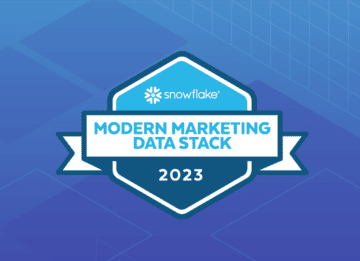6 Ways To Know if Account-Based Marketing is Right For Your B2B Business
If you’re considering a leap into account-based marketing (ABM), you’ll probably have a few questions. It’s a big investment and your first questions should be: How do I know if ABM is right for my business?
ABM is a buzzy marketing strategy in the B2B world, and you may be tempted to jump right in just because you hear it heralded constantly as a more efficient way to grow sales. But in truth, it’s not for every business.
The TL;DR version of this article: ABM is perfect for agile businesses with a bit of leeway in their marketing budgets, connections in their industry and big-fish accounts that comprise the bulk of their target market. Now, let’s break down that sentence into its logical components, each of which should apply to you if you want to seriously contemplate account-based B2B marketing.
Ask yourself these questions, and if the answer is “yes” to most (or even all!) of them, then you’re in good shape.
1. Can you afford the investment in ABM?
This style of marketing is a major investment. The internal resources you’ll need are:
- Tailored content creation
- Modified landing pages
- Shaped sales funnels
- Higher wages to staff for longer processes
- Quick analysis of data in real-time
- Regularly adjusted data based on results
Legacy companies may have established ABM efforts already in place, but if you’re reading this, there’s a good chance you’re just getting started. Don’t sweat it. As a newcomer, you’re in a great position to disrupt the legacy mindset and prove yourself a contender in your industry sphere.
2. Will your ABM investment pay off?
If you answered “yes” to the first question, that’s awesome—but it’s not enough.
Your B2B business must also be able to return your investment, and it’s typically not worthwhile for companies that serve small customers in high volume. There’s a reason we recommend starting off with just a dozen or so targeted ABM accounts. The marketing style, by definition, lends itself to a few, highly qualified accounts. You have to hone in on your target customers realistically and get a conversion, not just attract more leads.
3. Do you know exactly who you’re marketing to?
ABM works best when you already know exactly who your ideal customers are. If you’re a B2B business selling POS (point-of-sale) units in New York City, you might start by looking at your most profitable customers. Once you know who you need to be marketing to, you can create a targeted list with the key decision makers at your key accounts.
Then, hyper-target the myriad independent cafes, restaurants and stores that are similar to your best customer and are opening up in New York within the next year. By targeting them specifically, you can increase the chances they will be interested in learning more about your product.
Traditional marketing strategies would not involve targeting these accounts specifically; instead you might create a number of PPC campaigns or start an inbound marketing campaign with blogs and webinars. And that would work fine to drive traffic and fill the sales funnel, it’s worthwhile to keep those efforts going simultaneously.
But inbound marketing, almost by definition, is a waiting game. It relies on casting a wide net in hopes that you have handful of qualified leads in the end. If you know who you’re going after, why wait for them to find you? Why not find them?
4. Does your target customer know you exist?
The answer to this is probably going to be “no,” particularly if you’re a smaller B2B business. That’s a good thing. Account-based marketing makes the most sense if you’re trying to introduce your company to someone.
This is the disruptor’s mindset for good reason. If you are a known brand such as Hootsuite, you may be using ABM on a more sophisticated enterprise level. But the truth is, prospects will find Hootsuite in a simple Google search while looking for social media management platforms.
On the other hand, if you’ve created a social media management platform and nobody has ever heard of you, then ABM is your gateway ticket to name recognition.
DuckDuckGo, a relatively small search engine focused on user privacy, is not a B2B company, but they use this mentality well in their Twitter ads:
Odds are very few people had heard of DuckDuckGo before, but the ad—repeated often enough in Twitter feeds targeted at their ideal audience—is a great way to boost your name recognition and drive an online conversation. In ABM, that’s half the battle.
5. Do you already create distinct, engaging content?
If the answer is “yes,” good. Keep it that way. Note that this shouldn’t be a distinct requirement for companies using ABM; it’s just always a good idea to have content that resonates with your personas.
If the answer is “no,” you’ve got some legwork to do before getting into the ABM game.
6. Are your sales and marketing teams working together?
When your sales and marketing teams are not communicating, odds are you’re working with a legacy mindset that assumes handing off leads means the marketing team’s job is done. This isn’t ideal—it keeps valuable information siloed off between divisions and hinders the sales process.
If your sales and marketing teams are already aligned, then you’re set—ABM is a natural transition. Your company culture is already well-positioned to target your big-fish leads.
And if you’re still in the legacy mindset, there’s good news: it’s never too late to transition. Start with an all-in-one sales and marketing CRM and track your target customers along the sales funnel from start to finish. Adjust your marketing efforts as you discover what leads to real conversions and keeps your business thriving.
Recent Blogs
-
 September 21, 2023 Discover How FullContact is Building Trusted Customer Relationships through Snowflake's Native Application Framework Customer 360, Website Recognition, Identity Resolution
September 21, 2023 Discover How FullContact is Building Trusted Customer Relationships through Snowflake's Native Application Framework Customer 360, Website Recognition, Identity Resolution -
 September 20, 2023 Transform Your Customer Experience with FullContact Customer Recognition and Boost Your Conversions Website Recognition, Identity Resolution
September 20, 2023 Transform Your Customer Experience with FullContact Customer Recognition and Boost Your Conversions Website Recognition, Identity Resolution -
 September 14, 2023 FullContact Recognized as a Leader in Snowflake’s Modern Marketing Data Stack Report FullContact News, Partnership
September 14, 2023 FullContact Recognized as a Leader in Snowflake’s Modern Marketing Data Stack Report FullContact News, Partnership

